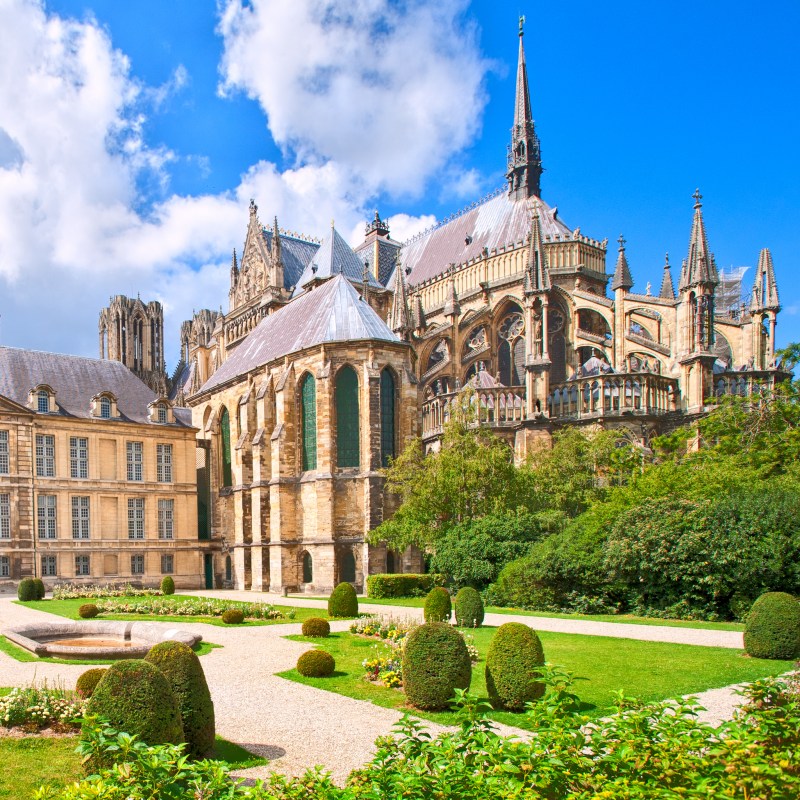
Reims, less than an hour by train from central Paris, is the capital of the Champagne region. And there you already have it: the reason to visit. If you really need another reason, Reims is also a superbly historic city dating back to Roman times. Reims saw the kings of France crowned in its cathedral, had its citizens hiding in the network of chalk tunnels and caves under the city during world wars. Yes, it also has a historic champagne industry that you will find hard to escape from visiting. Not that you will want to.
Videos by TravelAwaits
The city is interesting to visit throughout the year, except for maybe September, as some of the champagne houses will be closed during harvest time. But there are always some open, and the bars and restaurants never run out, so September might just be a good time to visit the historic sights, without the champagne houses distracting you too much. Up to you.

Cathedrale Notre-Dame De Reims
Traditionally the place where French kings were crowned, with 33 coronations having taken place over a span of 1,000 years in this cathedral and its predecessor, the cathedral was built between 1211 and 1345 in the High Gothic style. Over the centuries, the cathedral withstood many fires, restorations, and even changes in its status. It was turned briefly into a grain store during the French Revolution and a hospital during World War I. Badly destroyed during World War I, the cathedral was restored to its former glory and re-opened in 1938, and was added to the UNESCO World Heritage list in 1991.
Look out for the Rose Window and the stained-glass windows in the axial chapel designed by Marc Chagall but executed by Charles Marq in 1974. There is also a lovely smiling angel by the northern portal on the western facade. If you feel fit, climb the 249 steps up the tower for views across the city.
Pro Tip: Book a combined ticket to the cathedral and the Palais du Tau.

The Palais Du Tau
The cathedral and the Palais are sights that need to be visited together. The palace exhibits many of the cathedral’s treasures, such as rich tapestries, religious relics, and statues, and both were named UNESCO sites in 1991. Steps away from the cathedral, the Palais du Tau was the residence of French kings awaiting their coronation and the residence of the city’s archbishop.
The palace has evolved and changed over the centuries, with a Gallo-Roman villa dating to the 500s reportedly standing in the space originally. Over the years, the architecture and shape changed, resulting in a T-shaped building, giving the palace its name derived from the Greek word Tau for T, the name first mentioned back in 1131. The building was transformed into a classical palace between 1671 and 1710 under instruction from Louis XIV. It was then destroyed by fire in World War I and restored after World War II to its former splendor.
Pro Tip: The great hall of the Palais du Tau has a magnificent wooden roof. Make sure you bring a wide-angle lens if you are a keen photographer.

Porte De Mars And The Cryptoporticus
Stepping back a bit further in time, the Porte de Mars is a triumphal arch dating to the 3rd century. Standing on the outer ring of the old town, it has three arches and was built in honor of Emperor Augustus, but it was named after the once nearby Temple of Mars. Once a gate through the ramparts, the wall surrounding the old city, it now stands somewhat forlorn by the side of a main road.
Right in the center of the old town, you can find the cryptoporticus, a covered passage, lying half buried on the Place du Forum. It also dates to the 3rd century and was once built as a grain store. This well-preserved example is one of only five known cryptoporticus in the world.
Pro Tip: Have dinner in the lovely Le Crypto restaurant just alongside the square. A great setting and fabulous food.

The Basilica Of St-Remi
The third of the four UNESCO heritage sites in Reims, this medieval abbey was built back in the 11th century, on the site of a chapel where Saint Remigius, the Bishop of Reims, who baptized King Clovis, was buried. Consecrated by Pope Leo IX in 1049, the old part and more modern additions dating to the 12th to 19th centuries make up the largest Romanesque church in Northern France. The site offers an intriguing mix of styles inside and out. Inside, the aisle is impressive, being nearly 400 feet long but only 85 feet wide.
Pro Tip: The St-Remi Museum next door houses artifacts relating to Saint Remi and other parts of Reims’ history, including militaria. It also has a glorious main staircase.

Musee-Hotel Le Vergeur
Steps from the Roman cryptoporticus lies this 16th-century house once belonging to rich merchant Nicolas Le Vergeur and later to Hugues Krafft, who was a dedicated collector and left his house and collections to the Association of the Friends of Old Reims after this death. Older parts of the building date to the 13th century. There are some interesting examples of historic architecture, such as the enormous fireplace inside and the half-timbered outside, plus the gardens, that alone make a visit worthwhile. But add to this a selection of true gems, ranging from many original drawings by Albrecht Durer and a fine collection of Meissen porcelain, plus an eclectic mix of art and gothic furniture, and you can easily spend a couple of happy hours inside the museum.
Pro Tip: Le Vergeur Museum is only open in the afternoons from 2 p.m. to 6 p.m. and is closed on Mondays.

Musee De La Reddition (Museum Of The Surrender)
When you find yourself in this nondescript street outside the old town center, somewhere behind Reims’ train station, looking at an old technical college, you don’t quite expect the true sense of history that will envelop you once inside the Museum of the Surrender. But U.S. General Dwight D Eisenhower chose this place as his headquarters at the end of World War II, and it was here that the surrender of Nazi Germany was signed at 2:41 a.m. on May 7, 1945, ending the war. The room was left just as it was then, with the original Allied battle maps still covering all the walls around the conference table. There are rooms displaying military uniforms, memorabilia, and photographs, plus a film covering the events, in several languages.
Pro Tip: On the way back into town, you will be crossing between the Memorial of the Victims of the Gestapo and the Roman Porte de Mars. A little further on, you’ll notice the hangar-like Halles du Boulingrin, the market built by Emile Maigrot and the engineer Eugene Freyssinet in 1927. The market is open Wednesday, Friday, and Saturday mornings.

Musee Des Beaux-Arts
Located in a former abbey, this fine arts museum combines a historic setting with an excellent collection of art ranging from the 16th to the 21st centuries. The paintings and sculptures are displayed in grand rooms painted in colors from chocolate to pink, working very well with the art, offering a very photogenic fusion between old and new. You will find old favorites such as Renoir and Monet, plus an entire section dedicated to stained glass.
Pro Tip: Right next door, you will find the Reims Opera, originally built in 1866, then destroyed during World War I. It was restored in superb Art Deco style inside, complete with a stunning light in the domed ceiling, while the outside still impresses with its late 1800s facade.

The Champagne Houses
And, as I mentioned in the introduction, there is no getting around the champagne that permeates every inch of Reims, so much so that the champagne cellars of Reims are, in fact, the fourth UNESCO site in the city. Now, which one you chose to visit is up to your personal taste, but may I recommend that you visit at least two? Not just for the tasting sessions, of course, but the houses and their cellars are indeed quite different, with the miles of tunnels where the champagne is matured, looked after, and stored, and the various designs ranging from clear cut and reasonably modern-looking to ancient and quite spooky.
My two favorites are Veuve Clicquot for its modern and superbly fun marketing and Taittinger for its more affordable but still historic approach. Whichever house you visit, while you are being led through the miles of tunnels below, don’t just look at the expanses of champagne bottles, however impressive. Look at the chalk walls and the graffiti and art on them. These caves and tunnels provided shelter for the citizens of Reims during World War I, and sections were made into hospitals, shelters, workplaces, and more. People left their marks, from names and dates to art depicting faces and horses. Everything is still perfectly preserved, making each tour a learning experience about the art of making champagne and the history of Reims.
Pro Tip: Make sure you go out for a decent breakfast before you head out to the champagne houses. A great place for a coffee and a few croissants in a traditional setting and with good people-watching is the Cafe du Palais.
France offers a bounty of adventures from wine and delicious cuisine to architecture and tours into the past. Here are a few of our other recommendations.
